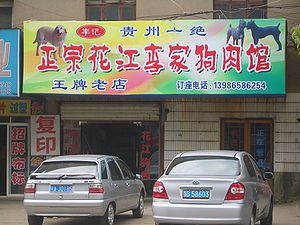Food and drink prohibitions/ja: Difference between revisions
Created page with "===内臓肉=== thumb|イスタンブールの市場で売られている頭部、[[Brain (as food)/ja|脳、蹄、トライプ]] thumb|[[Kale Pache/ja|Kale Pache、イランにおける伝統的なスープで、羊の頭部(脳、眼球、舌を含む)および蹄で作られる]] 内臓肉とは、屠殺された動物の内臓を指し、甘いパンや腎臓..." |
No edit summary |
||
| (27 intermediate revisions by the same user not shown) | |||
| Line 240: | Line 240: | ||
[[Offal/ja|内臓肉]]とは、屠殺された動物の内臓を指し、[[sweetbread/ja|甘いパン]]や[[kidney/ja|腎臓]]といった内臓肉に加えて、頭部や足(「蹄」)といった死骸の部位を含むことがある。内臓肉は多くの[[European cuisine/ja|ヨーロッパ料理]]や[[Asian cuisine/ja|アジア料理]]において伝統的な要素であり、イギリスの[[steak and kidney pie/ja|ステーキ・アンド・キドニーパイ]]や、スペインの[[Callos/ja|''カジョス・ア・ラ・マドリレーニャ'']]などの料理に見られる。[[Haggis/ja|ハギス]]は[[:en:Scotland|スコットランド]]において[[national dish/ja|国民的料理]]とされており、その歴史は[[:en:Robert Burns|ロバート・バーンズ]]の時代にまで遡る。ブラジル北東部には、ヤギの胃で作られる[[buchada/ja|「''ブチャーダ''」]]と呼ばれる、ハギスに類似した料理が存在する。 | [[Offal/ja|内臓肉]]とは、屠殺された動物の内臓を指し、[[sweetbread/ja|甘いパン]]や[[kidney/ja|腎臓]]といった内臓肉に加えて、頭部や足(「蹄」)といった死骸の部位を含むことがある。内臓肉は多くの[[European cuisine/ja|ヨーロッパ料理]]や[[Asian cuisine/ja|アジア料理]]において伝統的な要素であり、イギリスの[[steak and kidney pie/ja|ステーキ・アンド・キドニーパイ]]や、スペインの[[Callos/ja|''カジョス・ア・ラ・マドリレーニャ'']]などの料理に見られる。[[Haggis/ja|ハギス]]は[[:en:Scotland|スコットランド]]において[[national dish/ja|国民的料理]]とされており、その歴史は[[:en:Robert Burns|ロバート・バーンズ]]の時代にまで遡る。ブラジル北東部には、ヤギの胃で作られる[[buchada/ja|「''ブチャーダ''」]]と呼ばれる、ハギスに類似した料理が存在する。 | ||
[[heart/ja|心臓]]、[[Beef tongue/ja|舌(牛)]]、[[liver/ja|肝臓]](鶏、牛、豚)、天然[[sausage/ja|ソーセージ]]の[[Casing (sausage)/ja|ケーシング]]として使用される腸を除き、アメリカ合衆国で消費される内臓肉は地域的または民族的な料理に限られる傾向にある。たとえば、[[tripe/ja|トライプ]]は[[Menudo (soup)/ja|メヌード]]や[[sopa de mondongo/ja|モンドンゴ]]として[[:en:Hispanic and Latino Americans|ヒスパニック系アメリカ人]]や[[:en:Latinos and Hispanos|ラティーノ]]に、[[chitterlings/ja|チタリング]]は[[:en:Southern United States|アメリカ南部]]に、[[scrapple/ja|スクラップル]]は東海岸沿いに、[[fried-brain sandwich/ja|脳みそ揚げサンドイッチ]]は[[:en:Midwestern United States|中西部]]に、[[testicle/ja|睾丸]]は[[Rocky Mountain oysters/ja|ロッキーマウンテン・オイスター]]または「プレーリー・オイスター」として西部に見られる。アルゼンチンや他のスペイン語圏諸国では、雄牛の睾丸が''huevos de toro''(「雄牛の卵」)として提供される。 | |||
[[:en:European Union|欧州連合]]など一部の地域では、[[Brain (food)/ja|脳]]やその他の臓器が[[:en:bovine spongiform encephalopathy|牛海綿状脳症]](「狂牛病」)や類似の疾患を伝播する可能性があるため、これらは[[food chain/ja|食物連鎖]]から[[:en:specified risk material|特定危険部位]]として排除され、禁止されている。 | |||
ヤギ、牛、羊、水牛の胃を食べることが禁忌である場合もあるが、古代の[[:en:Cheesemaker|チーズ製造者]]たちは胃([[rennet/ja|レンネット]]を含む)を利用して[[milk/ja|牛乳]]を[[cheese/ja|チーズ]]へと変える技術を用いていた。これは潜在的に禁忌となる過程である。現代のチーズ製造技術では、レンニンやキモシンに類似した細菌酵素を用いた生化学的プロセスが採用されている。すなわち、チーズ自体ではなく、チーズを製造する「過程」が、厳格な菜食主義者にとって禁忌か否かを決定する要素となる。 | |||
===ケシの種=== | |||
== | {{main/ja|Poppy seed/ja}} | ||
{{main|Poppy seed}} | [[Poppy seed/ja|ケシの種]]は多くの文化で香辛料として使用されるが、微量に含まれる[[morphine/ja|モルヒネ]]や[[codeine/ja|コデイン]]により、薬物検査で[[:en:false positive|誤って陽性]]と判定される可能性がある。[[:en:Singapore|シンガポール]]では、ケシの種は[[:en:Central Narcotics Bureau|中央麻薬取締局]](CNB)によって「禁制品」に分類されている。 | ||
[[Poppy seed]] | |||
===豚肉=== | |||
=== | {{Main/ja|:en:Religious restrictions on the consumption of pork}} | ||
{{Main|Religious restrictions on the consumption of pork}} | [[:en:United States Department of Agriculture|アメリカ合衆国農務省]](USDA)のデータによると、[[pork/ja|豚肉]]は世界で最も広く食べられている肉である。豚肉の摂取は、[[:en:Islam|イスラム教]]、[[:en:Judaism|ユダヤ教]]、そして[[:en:Christian denomination|セブンスデー・アドベンチスト教会]]などの特定のキリスト教の宗派によって禁じられている。この禁止は、関係する宗教の聖典、例えば[[:en:Qur'an|クルアーン]]2:173、5:3、6:145、16:115、および[[:en:Deuteronomy|申命記]]14:8に規定されている。豚はまた、古代中東の少なくとも他の3つの文化、すなわち[[:en:Phoenicia|フェニキア人]]、[[:en:Ancient Egypt|エジプト人]]、[[:en:Babylonia|バビロニア人]]においてもタブーであった。いくつかの例では、タブーは豚肉を食べることにとどまらず、豚に触れることさえ、あるいは豚を見ることさえタブーであった。 | ||
[[United States Department of Agriculture]] | |||
このタブーの本来の理由は議論されている。[[:en:Maimonides|マイモニデス]]は、豚の不潔さは自明であると考えていたようだが、特にその[[:en:feces|排泄物]]を食べる傾向に強い嫌悪感を示している。19世紀には、一部の人々が[[:en:Middle East|中東]]における豚のタブーを[[:en:trichinosis|旋毛虫]]の危険性に帰したが、この説明は現在では支持されていない。[[:en:James George Frazer|ジェームズ・ジョージ・フレーザー]]は、古代イスラエル、エジプト、シリアにおいて、豚は元々聖なる動物であり、そのため食べたり触れたりすることができなかったと示唆した。このタブーは、豚がもはや聖なるものと見なされなくなった時代まで生き残り、不潔であるという理由で説明されるようになった。 | |||
より最近では、[[:en:Marvin Harris|マーヴィン・ハリス]]が、豚は生態学的・社会経済的レベルで中東での飼育に適していないと提唱した。例えば、豚は他の動物よりも涼しく保つためにより多くの水を必要とし、放牧する代わりに穀物などの食料を人間と競合するため、乾燥気候での生活には適していない。そのため、豚を飼育することは浪費的で退廃的な行為と見なされた。このタブーに対する別の説明として、豚は[[Omnivore/ja|雑食性]]であり、その自然な食習慣において肉と植物を区別しないことが挙げられる。肉を食べる意欲は、一般的に食べられている他のほとんどの家畜(牛、羊、山羊など)が自然には植物のみを食べるのとは対照的である。[[:en:Mary Douglas|メアリー・ダグラス]]は、ユダヤ教における豚に対するタブーの理由は3つあると示唆した。(i)ひづめが分かれているが反芻しないため、有蹄類の範疇を逸脱するから、(ii)死肉を食べるから、(iii)非イスラエル人が食べていたからである。 | |||
[[meat alternatives/ja|豚肉代替品]](例えば、[[Impossible Foods/ja|インポッシブル・フーズ]]によるもの)は実際の豚肉を含まないが、イスラム教などの一部の保守的な宗教団体は、その代替品が模倣し提示しようとしている「[[haram/ja|ハラム]]」または[[:en:kosher|非コーシャ]]な製品であるため、肉をベースにしたものと同様に禁じられていると見なしている。[[Lab-grown meat/ja|培養豚肉]]もまた、ハラムまたは非コーシャと見なされる可能性がある。 | |||
===ウサギ=== | |||
=== | {{Main/ja|Rabbit/ja#As food and clothing}} | ||
{{Main|Rabbit#As food and clothing}} | [[File:Rabbit edit.jpg|thumb|[[Cottontail rabbit/ja|ワタオウサギ]]]] | ||
[[File:Rabbit edit.jpg|thumb|[[Cottontail rabbit]]]] | [[:en:Bible|聖書]]の[[:en:Book_of_Leviticus|レビ記]]では、[[rabbit/ja|ウサギ]]は[[unclean animals|不浄な動物]]に分類されている。これは、ウサギが[[Ruminant/ja|反芻動物]]の「反芻」に相当する、部分的に消化された物質を咀嚼し再摂取するにもかかわらず、ひづめが分かれていないためである。ウサギの摂取は[[:en:Sunni Islam|スンニ派イスラム教]]では許可されており、いくつかのスンニ派が多数を占める国(例:[[:en:Egypt|エジプト]]では、''[[mulukhiya/ja|モロヘイヤ]]''の伝統的な材料である)で人気があるが、[[:en:Twelvers|十二イマーム派]]の[[:en:Ja'fari jurisprudence|ジャアファリー法学]]では禁じられている。 | ||
===ラットとマウス=== | |||
{{further/ja|Rat meat/ja|Mouse/ja#As food}} | |||
{{further|Rat meat|Mouse#As food}} | ほとんどの西洋文化において、[[rat/ja|ネズミ]]および[[mouse/ja|ハツカネズミ]]は不潔な[[vermin/ja|害獣]]またはペットと見なされており、伝統的に[[Bubonic plague/ja|ペスト]]の媒介者とされ、人間の食用には適さないとされている。 | ||
[[:en:Ghana|ガーナ]]では、''Thryonomys swinderianus'' は地元で「Akrantie」、「Grasscutter」、および(誤って)「[[Aethomys/ja|ブッシュラット]]」と呼ばれ、一般的な食材である。この齧歯類の正しい一般名は「グレーター・ケーンラット」であるが、実際にはネズミではなく、[[porcupine/ja|ヤマアラシ]]やモルモットの近縁種であり、[[:en:Sahara|サハラ砂漠]]以南の[[:en:Africa|アフリカ]]に生息している。2003年、アメリカ合衆国はこの動物および他のアフリカ産齧歯類の輸入を禁止した。これは、[[:en:Western Hemisphere|西半球]]でそれまで報告されたことのなかった[[monkeypox/ja|サル痘]]の少なくとも9例の人間感染が発生したことによるものである。 | |||
ユダヤ教およびイスラム教では、いかなる種類の齧歯類やそれに由来する物質の消費も禁じられている。 | |||
===爬虫類=== | |||
=== | ユダヤ教およびイスラム教では、[[reptile/ja|爬虫類]]、たとえば[[crocodile/ja|ワニ]]や[[snake/ja|ヘビ]]の消費を厳しく禁じている。他の文化においては、[[alligator/ja|アリゲーター]]などの食材は珍味とされ、[[:en:Crocodile farm|商業的に飼育]]されている。 | ||
===野菜、果物、スパイス=== | |||
== | ジャイナ教、仏教、ヒンドゥー教の一部宗派では、[[Allium/ja|ネギ属]]の野菜の消費が制限されている。信者らはこれらが有害な情動を刺激すると信じている。多くのヒンドゥー教徒は、祭礼や[[:en:Hindu calendar|ヒンドゥー教の聖月]]であるシュラワン、プラタッシ、カルティックの期間中、玉ねぎやニンニクを非菜食料理とともに食べることを避ける。しかし、玉ねぎやニンニクを忌避する習慣は、非菜食料理の忌避に比べて一般的ではなく、多くの人々がこの習慣に従っていない。 | ||
[[:en:Kashmiri people|カシミール人]]のバラモンは「強い風味」の食物を禁じている。これにはニンニク、玉ねぎ、[[black pepper/ja|黒胡椒]]や[[chili pepper/ja|唐辛子]]などの香辛料が含まれ、舌を刺激する刺激的な風味が低俗な感情を煽ると信じられている。 | |||
[[Kashmiri people| | |||
[[:en:Jain vegetarianism|ジャイナ教徒]]は肉類を消費しないだけでなく、[[List of root vegetables/ja|根菜類]](人参、ジャガイモ、大根、カブなど)も食べない。これは植物を殺すことになるためであり、彼らは[[:en:ahimsa|アヒンサー(非暴力)]]を信じているためである。生物の階層において、玉ねぎのような越冬植物は小麦や米のような食用作物よりも高位に位置づけられている。玉ねぎが季節の変化を認識し春に開花する能力は、下等植物にはない「感覚」と見なされている。生成される悪業(カルマ)の量は、その生物が持つ感覚の数に比例するとされており、玉ねぎの摂取を避けることが賢明とされる。これにより、北インドの一部の伝統では、事実上すべての越冬植物が禁忌とされている。 | |||
[[Jain vegetarianism| | |||
中国の[[:en:Buddhist cuisine|仏教料理]]では、伝統的に[[garlic/ja|ニンニク]]、''[[Allium chinense/ja|Allium chinense]]''、[[asafoetida/ja|アサフェティダ]]、[[shallot/ja|エシャロット]]、および''[[Allium victorialis/ja|Allium victorialis]]''(ビクトリーオニオンまたはマウンテンリーキ)の使用が禁じられている。 | |||
[[:en:Yazidism|ヤズィーディー教]]においては、[[lettuce/ja|レタス]]および[[Phaseolus lunatus/ja|バタービーンズ]]の摂取が禁忌とされている。イスラム教の宗教教師で学者のファラフ・ハッサン・ジュマは、レタスに悪が宿るというこの宗派の信仰を、イスラム教徒による長年の迫害の歴史に結びつけている。歴史的な説によれば、13世紀に[[:en:Mosul|モースル]]を支配していた冷酷な君主が、ある初期のヤズィーディーの聖者を処刑するよう命じ、熱狂した群衆がその遺体にレタスの頭を投げつけたとされる。 | |||
[[:en:Pythagoreanism|ピタゴラス教団]]の信者は菜食主義者であり、「ピタゴラス主義者」はかつて「菜食主義者」と同義語とされていた。しかし、[[:en:Pythagorean diet|彼らの教義]]では豆の摂取が禁じられていた。理由は明らかではないが、[[flatulence/ja|膨満感]]の原因となること、あるいは[[Glucose-6-phosphate dehydrogenase deficiency/ja|ソラマメ中毒]]からの保護、しかし最も可能性が高いのは[[:en:magico-religious|宗教的・神秘的]]な理由によるとされている。ピタゴラスの死に関する一つの伝説では、彼が敵から逃げる際にソラマメ畑を突っ切ることを拒んだために殺されたとされる。 | |||
[[broccoli/ja|ブロッコリー]]や[[cauliflower/ja|カリフラワー]]などの野菜は禁忌ではないものの、虫や[[:en:worm|蛆虫]]がその多くの隙間に潜んでいる可能性があるため、敬虔なユダヤ教徒や他の宗教の信者によって忌避されることがある。同様に、[[blackberry/ja|ブラックベリー]]や[[raspberry/ja|ラズベリー]]のような果物も、果実を破壊せずには十分に洗浄できないため、カシュルート機関から忌避が推奨されている。 | |||
[[Egyptian cuisine/ja|エジプト料理]]の一般的な料理である[[mulukhiyah/ja|ムルキーヤ]]は、[[jute/ja|ジュート]]の葉を主材料としたスープであり、他の料理用途はなかった。この料理は、996年から1021年の間に在位した[[:en:Fatimid Caliphate|ファーティマ朝]]の[[:en:Caliph|カリフ]]、[[:en:Al-Hakim bi-Amr Allah|アル=ハーキム・ビ=アムル・アッラー]]によって禁止された。この禁止令はムルキーヤだけでなく、スンナ派の人々が食べるとされた他の食品にも及んだ。この禁止令は彼の治世終了後に解除されたが、アル=ハーキムを崇敬し、彼に準神格的な権威を与える[[:en:Druze|ドルーズ派]]は現在もこの禁令を尊重し、いかなる種類のムルキーヤも食べない。 | |||
===クジラ=== | |||
{{Main/ja|Whale meat/ja}} | |||
{{Main|Whale meat}} | スンニ派イスラム教では、自然死したクジラの肉を食べることが許可されている。これは、ムハンマドがそれを認めたとされる有名なスンニ派のハディースがあるためである。シーア派イスラム教では、クジラは鱗を持たないため、その肉は[[Haram/ja|ハラーム]](禁じられたもの)とされている。世界の多くの地域では、クジラの絶滅危惧によりクジラ肉は食されていないが、伝統的に禁じられているわけではない。[[:en:United Kingdom|イギリス]]のような国々では、クジラ肉の輸入が法律で禁じられている。 | ||
< | <span id="Prohibited_drinks"></span> | ||
== | ==禁止飲料== | ||
===アルコール飲料=== | |||
=== | {{See also/ja|:en:Christianity and alcohol|:en:Islam and alcohol|:en:Religion and alcohol}} | ||
{{See also|Christianity and alcohol|Islam and alcohol|Religion and alcohol}} | 仏教、イスラム教、ジャイナ教、[[:en:Rastafari movement|ラスタファリ運動]]、[[:en:Baháʼí Faith|バハイ教]]、および[[:en:Baptists|バプテスト派]]、[[:en:Pentecostalism|ペンテコステ派]]、[[:en:Methodism|メソジスト派]]、[[:en:Latter Day Saint movement|末日聖徒イエス・キリスト教会(モルモン教)]]、セブンスデー・アドベンチスト教会、[[:en:Iglesia ni Cristo|イグレシア・ニ・クリスト]]などのキリスト教の諸派では、[[alcoholic beverage/ja|アルコール飲料]]の消費を禁じるか、あるいは忌避している。 | ||
ヘブライ聖書には、[[:en:Book of Numbers|民数記]]6章1〜21節において、[[:en:Nazirite|ナジル人の誓願]]が記述されており、そこには[[:en:abstinence|禁酒]]、特に[[wine/ja|ぶどう酒]]およびおそらく[[Barley wine/ja|大麦ビール]]([[:en:Septuagint|七十人訳聖書]]および[[:en:Bauer lexicon|バウアー辞典]]によれば ''σικερα''、[[:en:Akkadian Empire|アッカド語]]の shikaru〈大麦ビール〉に由来)を含むことが記されている。[[:en:New Jewish Publication Society of America Version|新JPS訳聖書]]では「ぶどう酒および他のいかなる酩酊物」と訳されている。他の翻訳、たとえばNIVでは、アルコールおよびワインビネガーのようなアルコール由来製品もすべて禁じられている。ユダヤ教全般としてはアルコールに対する普遍的な禁忌は存在しない。 | |||
また、[[:en:Teetotalism|絶対禁酒主義]]や[[:en:Temperance movement|節酒運動]]に見られるように、アルコール消費に対する文化的な禁忌も存在する。さらに、[[:en:International Labour Conference|国際労働会議]]による[[:en:Maternity Protection Convention, 2000|2000年母性保護条約]]などに見られるように、妊娠中の女性によるアルコール摂取は健康上の理由から多くの国において文化的禁忌とされる傾向もある。 | |||
'''アブサン''' | |||
''' | |||
[[Absinthe/ja|アブサン]]は、その高いアルコール度数のため、1912年にアメリカ合衆国で違法とされた。アブサンは2007年に再び合法化された。幻覚の原因となると噂され、「緑の妖精」というニックネームが付けられた。 | |||
[[Absinthe]] | |||
===血液=== | ===血液=== | ||
Latest revision as of 09:04, 29 July 2025
一部の人々は、様々な宗教的、文化的、法的、あるいはその他の社会的な禁止に従って、特定の食物や飲料を摂取しません。これらの禁止の多くはタブーに該当する。多くの食物タブーやその他の禁止は、特定の動物の肉、例えば哺乳類(齧歯類など)、爬虫類、両生類、魚、軟体動物、甲殻類、昆虫などを禁じている。これは、植物性食品よりも肉に対して嫌悪反応がより頻繁に起こることと関係しているかもしれない。禁止の中には、動物の特定の部位や排泄物に特化しているものもあれば、植物や菌類の摂取を控えるものもある。
一部の食物禁止は、どのような食物や食物の組み合わせが食べてはならないか、動物がどのように屠殺されるべきか、あるいは調理されるべきかについて、宗教法やその他の形で定められた規則として定義される。これらの禁止の起源は様々である。ある場合には健康上の配慮や実用的な理由が背景にあると考えられ、別のケースでは人間の象徴体系に関連しているとされる。
ある種の食物は、特定の宗教的な期間(例:四旬節)、人生の特定の段階(例:妊娠)、あるいは特定の階層の人々(例:司祭)に対して禁止されることがあります。これは、その食物が通常は許容されている場合でもです。比較的に見ると、ある集団には不適格とされるものが、同じ文化圏あるいは異なる文化圏の別の集団には完全に受け入れられていることがあります。食物タブーは通常、人間を精神的または身体的な害から守ることを目的としているように見えますが、その存在理由として文化内で他にも様々な説明が与えられます。宗教的・精神的起源とされるものを含め、多くのタブーには生態学的あるいは医学的背景が見られます。食物タブーは資源の有効利用を助けることがありますが、特定の集団のみに適用されると、食物の独占につながることもあります。ある特定のグループや部族が共有するタブーは、グループの結束を促し、他者と区別されることでアイデンティティを保ち、「帰属意識」を生み出すのに寄与します。
原因

様々な宗教は、特定の種類の食物の摂取を禁じている。例えば、ユダヤ教では、食べてよいものといけないものについての厳密な規則である’’カシュルート’‘が定められており、特に肉と乳製品の混合が禁じられている。イスラム教の食事規定でも同様の規則があり、食品を’’ハラーム’’(禁じられた)と’’ハラール’’(許された)に分類する。ジャイナ教徒は、宗教的な指示に従って菜食主義を守ることが多いです。ヒンドゥー教徒の中には牛肉を食べない人もおり、特に上位のカーストに属する人々の中には、菜食主義を理想とし、実践する人もいる。場合によっては、食品そのものではなく、調理の過程が問題視されることもある。例えば、中世初期のキリスト教では、調理されていない食物は疑わしいものとされることがあった。ベーダに帰属されるある悔悛書には、生の食物を食べた者に対する(軽い)悔悛の方法が示されているし、聖ボニファティウスは、教皇ザカリアスに、ベーコンが食用として適切になるまでどのくらい塩漬けにする必要があるのかを問う手紙を書いている(この手紙はボニファティウス書簡集第87通として残っている)。また、ハワイでは1819年までカプ制度が用いられていた。
公式な規則とは別に、ある動物の肉の摂取に対する文化的タブーも存在します。特定の社会では、一般的に「食品」として認識されていない範囲の肉は、食べるべきでないとされます。いわゆる「珍しい肉」——つまり、個人または文化にとって馴染みのない動物由来の食品——は、一般的に嫌悪反応を引き起こし、それが文化的タブーとして表現されます。たとえば、犬肉は、特定の状況下では韓国、ベトナム、中国で食べられるが、ほぼすべての西洋諸国では食物として不適切とされている。同様に、馬肉は英語圏ではほとんど食べられていませんが、カザフスタン、日本、イタリア、フランスなどでは国家料理の一部である。
時には、食物禁止が国家や地方の法律に組み込まれることもあります。たとえば、インドの多くの地域では牛の屠殺が禁止されており、アメリカ合衆国では馬の屠殺が禁止されている。中国に返還された後も、香港ではイギリス統治下に制定された、犬および猫の肉の供給を禁じる法律が撤廃されていない。
環境保護運動、倫理的消費、その他の活動家運動は、新たな食物禁止や食事ガイドラインを生み出している。比較的新しい文化的食物タブーの一例として、絶滅危惧種やその他法律や国際条約によって保護されている動物の肉や卵の摂取の禁止がある。例としては、一部のクジラ、ウミガメ、渡り鳥などが挙げられる。同様に、持続可能な水産物の助言リストおよび認証は、持続不可能な漁業方法に基づき、特定の海産物の摂取を控えるよう推奨する。有機認証では、化学合成物の使用や遺伝子組み換え生物、放射線照射、下水汚泥の使用を禁じている。フェアトレード運動とその認証制度は、搾取的な労働条件下で生産された食物やその他の製品の消費を思いとどまらせようとしている。地産地消運動や’’100マイルダイエット’’のような他の社会運動も、非地元産の食品の不使用を奨励しており、ヴィーガニズムでは、いかなる種類の動物性製品も使用または消費しないことを目指している。
禁止食品
両生類

ユダヤ教では、両生類(例えばカエル)の摂取を厳格に禁じている。この制限はレビ記11章29–30節および42–43節に記されている。両生類および他の禁忌とされる動物から派生した化学製品もまた避けなければならない。
他の文化では、カエルの脚のような食品は珍味として重宝されることがあり、状況によっては商業的に飼育されることもある。しかし、絶滅危惧種であるカエルが過剰消費によって絶滅の危機に瀕しているとの環境的懸念から、フランスなどの国ではその食用利用を制限する法的措置が講じられてきた。フランス農業省は1976年に在来のカエル種を保護する措置を開始し、その後も取り組みは継続されている。動物の大量商業捕獲は1980年に禁止されたが、国際的な輸入や個人による狩猟と調理は多くの地域で合法のままである。
コウモリ
ユダヤ教では申命記法典および祭司法典が明確にコウモリを禁じている。すべての肉食陸上動物の肉と同様に、コウモリの肉はイスラム教においてもハラーム(禁忌)とされる。
鳥類
トーラー(レビ記11章13節)には、ワシ、ハゲワシ、ミサゴを食べてはならないと明示されている。現在一部地域で肉用に飼育されているダチョウも、レビ記11章16節のいくつかの解釈においては明確に禁じられている。ラビたちは、猛禽類やスカベンジャー(自然界の掃除屋)を禁じる伝統が、他の鳥類とは異なる扱いを示しているとし、ニワトリ、アヒル、ガチョウ、シチメンチョウの摂取は許容されると解釈している。
これとは対照的に、イスラム教の食事規定ではダチョウの摂取は認められているが、鉤爪やかぎ爪で狩りをする猛禽類はユダヤ教と同様に禁じられている。
スカベンジャーや腐肉を食べる動物、例えばハゲワシやカラスは、多くの文化において病気の媒介者、不潔な存在、死を連想させるものとして食用を避けられている。例外としてルークは田舎料理として知られており、近年ではスコットランド料理のレストランでロンドンにて提供されたこともある。今日の西洋文化では、ほとんどの人々が鳴禽を裏庭の野生動物として扱い、食用とは見なしていない。
バロットは発育途中の鳥の胚(通常はアヒルまたはニワトリ)を殻ごと茹でて食べる料理である。クルアーンの一部には、適切に屠殺されていない動物やその製品は摂取してはならないという教義があり、そうした動物や製品は「maytah」とされる。バロットは発育途中の胚を含む卵であるため、イスラム教徒の間ではこれが「ハラーム」、すなわち「禁じられたもの」と見なされている。
ホオジロモズモドキは、フランスの美食家たちの間で近年タブー食品として知られるようになった。これらの小鳥は生きたまま捕獲され、強制的に餌を与えられた後、アルマニャックに溺死させられ、「丸焼きにされ、骨ごとすべて食べられる」。食事中、食べる者はリネンのナプキンで頭を覆い、貴重な香りを閉じ込めるため、または神の目から隠れるためだと信じられている。
ラクダ

ラクダの肉を食べることはトーラーによって厳格に禁じられている。トーラーは、反芻(逆流消化)する点ではウシ、ヒツジ、ヤギ、シカ、レイヨウ、キリン(これらはすべてコーシャー)と共通するものの、割れた蹄を持たないためラクダを不浄と見なしている。これらの動物と同様に、ラクダ(およびリャマ)は多室胃を持つ反芻動物である。ラクダは偶蹄類であり、足は二つに分かれているが、その足は硬い蹄ではなく柔らかいパッドで形成されている。
イスラム教では、ラクダの肉を食べることは認められており、サウジアラビアおよびアラビア半島のイスラム文化圏では伝統的な食物となっている。
ウシ
ウシは、インドなどの国々において伝統的に崇拝の対象とされている。ヒンドゥー教徒の中でも、特にバラモンは菜食主義であり、肉の摂取を厳格に控える。肉を食べる者であっても牛肉の摂取は避ける傾向にあり、これはウシがヒンドゥー教において神聖な存在とされているためである。例えば、伝統では女神であるカーマデーヌが願いを叶える神牛として現れるとされ、このような物語は世代を超えて語り継がれている。
牛の屠殺とは対照的に、乳製品(牛乳、ヨーグルト、特にギーと呼ばれるバターの一種)の摂取はインドで非常に一般的である。牛由来の製品はヒンドゥー教において重要な役割を果たしており、とりわけ牛乳は神聖視され、宗教儀式に頻繁に用いられている。
雄牛は農業初期において主要な労働力および輸送手段であり、インドが農耕社会へと移行する中で、ウシは非常に有用な動物であることが証明された。このような必要性から生まれた敬意が、ウシを食用として殺すことを避ける理由となった。例えば、飢饉に見舞われた村が雄牛を食べてしまえば、次の作付けの季節に犂や荷車を引く動物がいなくなってしまう。しかし、この仮説を裏付ける証拠はほとんど見つかっていない。飢饉に苦しむ地域では、次の季節まで生き延びるためにウシを食べることもある。
インドの法律では、雌牛の屠殺はほぼすべての州で禁止されており、例外はケーララ州、西ベンガル州および北東部の七姉妹州である。牛の屠殺や違法な輸送に関与した者は、多くの州で投獄される可能性がある。牛の屠殺は、多くのヒンドゥー教徒にとって極めて挑発的な問題である。
一部の中国仏教徒も牛肉の摂取を控えるよう勧めているが、それは禁忌とは見なされていない。しかし、スリランカの仏教徒(シンハラ人)にとっては、それは禁忌であり、牛の乳や労働力によって生活が支えられていることに対して「恩知らず」であると考えられている。
ミャンマーの仏教徒にも牛肉の摂取に対する禁忌がある。彼らは、ウシを人間と共に田畑で働く動物と見なしているためである。ただし、マンダレーやヤンゴンなどの都市部においては、厳密な禁忌とはされていない。
インドネシア・ジャワ島のクドゥス市では、住民の大多数がイスラム教徒であるにもかかわらず、牛肉の摂取に対する禁忌が存在する。これはヒンドゥー教徒への配慮に基づくものである。
チューインガム
シンガポールでは、1992年からチューインガムの販売が禁止されている。現在、シンガポールでガムを噛むことは違法ではないが、特定の例外を除き、輸入および販売が禁止されている。2004年以降、治療用、歯科用、ニコチン含有のチューインガムには例外が設けられ、医師または登録薬剤師から購入できる。
甲殻類およびその他の海産物

魚類以外のほぼすべての海産物、すなわち貝類、ロブスター、エビ、ザリガニなどは、水中に生息しながらひれおよびうろこの両方を持たないため、ユダヤ教においては禁止されている。
一般的な規則として、スンニ派イスラム教の3つの法学派では、ハナフィー派を除き、すべての海産物の摂取が許可されている。シーア派の多数が従うジャファル法学派では、うろこを持たない魚類以外の海産物は禁止されており、エビのみが例外とされている。
ハチミツ
ハチミツは、蜜および甘露をミツバチが吐き戻したものである。ミツバチ自体は食物としてコーシャではないが、ハチミツは例外としてコーシャとされている。通常、不浄な動物から得られた産物は不浄であるという規則に反するように見えるが、この点についてはタルムードで議論されており、ハチミツの起源は花にあり、ミツバチはそれを貯蔵し、脱水してハチミツにするのみであることから、摂取が許可されていると説明されている。これは、ミツバチが直接生成するローヤルゼリーとは異なり、ローヤルゼリーはコーシャではないとされる。
昆虫
ユダヤ教およびサマリア教において、特定のイナゴはコーシャ食品とされ得る(レビ記11章22節)。それ以外の昆虫はコーシャではないとされる。カシュルートの規定では、他の食品にも昆虫が混入していないかを入念に確認することが求められる。
イスラム教においては、ほとんどの昆虫の摂取は禁止されているが、イナゴは合法的な食品とされ、儀式的屠殺を必要としない。
犬

西洋諸国では、犬肉を食べることは一般にタブーとされているが、飢餓の脅威にさらされた場合にはこのタブーが破られることもあった。フリードリヒ大王の時代以来、ドイツではすべての主要な危機時に犬肉が食された記録があり、「封鎖マトン(blockade mutton)」という別称でも知られている。20世紀初頭には、ドイツにおいて犬肉の消費は一般的であった。アメリカ合衆国では、ドイツ移民が販売するフランクフルトソーセージの肉の出所に疑念が生じたことから、「ホットドッグ」という語が生まれた。1937年には、トリヒナに対応するため、豚、犬、イノシシ、キツネ、アナグマなどの肉食動物を対象とする食肉検査法が導入された。1986年以降、ドイツでは犬肉の販売は禁止されている。2009年には、ポーランドのチェンストホヴァ近郊の農場で犬を飼育し、ラード(smalec)に加工していたことが発覚し、スキャンダルとなった。
スイスでは、2012年のThe Localによる記事で、国内における犬肉の消費が続いていることが報告された。ドイツ語圏のアッペンツェルおよびザンクト・ガレンの農家が、個人的に犬を屠殺しているという憶測も浮上した。
古代ヒンドゥー教の文献(例:ManusmṛtiやSushruta Samhitaなどの医療文献)において、「犬の肉」は最も不浄(かつ毒性の強い)食品とされていた。犬肉はまた、ユダヤ教およびイスラム教の食規定においても不浄とされており、両宗教において犬肉の摂取は禁じられている。
アイルランド神話では、アルスター伝説の英雄Cú Chulainnが、犬肉を食べるという自身のタブーを破るか、もてなしを断るかの選択(モートンのフォーク)に迫られたとされる。彼は犬肉を食べることを選択し、それが死の原因となったとされる。
メキシコでは、先コロンブス期にショロイツクィントリという無毛の犬種が一般に食用とされていたが、植民地化後はこの習慣は廃れた。
東アジアでは、中国、ベトナム、北朝鮮および韓国を除き、ほとんどの国で犬肉の消費は稀である。これは、イスラム教や仏教の価値観、あるいは台湾における動物権利の意識によるものである。満州族には犬肉を食べることに対する禁忌があり、彼らの隣接する東北アジアの民族の一部では犬肉を食す文化もあるが、満州族自身は犬の毛皮で作られた帽子を着用することすら避ける。犬肉に対する禁忌は、満州族に加え、中国のモンゴル族、ミャオ族、中国系ムスリム、チベット族、ヤオ族、イ族にも見られる。インドネシアでは、イスラム教徒が多数を占めるため、犬肉の消費は禁止されているが、キリスト教徒であるバタック族およびミナハサ族の一部では、伝統的に犬肉を食する文化が存在する。
ニューギニア高地のウラプミン族は、近隣の部族とは異なり、犬を殺したり食べたりしない。また、犬が自分たちの食べ物に息を吹きかけることすら許さない。
クマ
クマはユダヤ教においてコーシャ動物と見なされていない。イスラム教においても、すべての肉食性の陸生動物と同様に、クマの肉は禁じられている。
ネコ
西洋世界の多く、特にアメリカ大陸およびヨーロッパでは、ネコを食べることに対して強いタブーが存在する。ネコの肉は、ユダヤ教およびイスラム教において禁じられており、両宗教は肉食動物の摂取を禁じている。西洋諸国では、ネコはペットまたは害獣の駆除を目的とした作業動物として扱われることが一般的であり、食用動物としては認識されていないため、ネコの摂取は多くの人々にとって野蛮な行為と見なされている。
en:Switzerlandスイスにおいても、The Localが2012年に発表した報告では、ネコ肉の消費が継続していることが明らかにされた。
卵
卵の摂取は、すべてのアブラハムの宗教において許可されている。
ジャイナ教徒は卵を食べることを控える。多くのヒンドゥー教徒や正統派のシク教徒の菜食主義者も卵を食べることを避ける。
血の斑点を自然に含む卵は、ユダヤ教およびイスラム教の伝統において食べることができないが、血のない卵は一般的に消費されており(肉とは見なされず、乳製品と共に食べることができる)。
象

仏教徒は象肉を食べることを禁じられている。
象肉は、ユダヤ教の食事規定においても、象が割れたひづめを持たず反芻動物でもないため、コーシャとは見なされない。
イスラム教の食事規定の一部の学者は、象が牙を持つまたは捕食性の動物に分類されるため、イスラム教徒が象を食べることは禁じられているとする。
ヒンドゥー教徒は、ガネーシャという神がヒンドゥー教徒の間で広く崇拝されていることから、象肉との接触を厳しく避ける。
カーリカ・プラーナでは、ヤギと象の儀式的な殺害を、それぞれbali(犠牲)とmahabali(大犠牲)として区別しているが、シャクティ神学における人間に関する記述は象徴的なものであり、現代では張りぼてによって行われている。
魚
魚を食べる口で私に話しかけないでください
—
ソマリ人の間では、大多数の氏族が魚の摂取を禁忌としており、魚を食べる少数の職業氏族とは婚姻関係を結ばない。
魚を食べることに対する禁忌は、多くの山地に住む牧畜民や農耕民(さらには一部の沿岸住民)にも見られ、これらはエチオピア、エリトリア、ソマリア、ケニア、北部タンザニアの一部に居住している。これはしばしば「クシ語族の魚禁忌」と呼ばれ、クシ語を話す人々が東アフリカに魚を避ける文化をもたらしたと考えられているが、すべてのクシ語話者が魚を避けているわけではない。魚禁忌の分布域は、おおむねクシ語族の言語が話される地域と一致し、一般的には、ナイル・サハラ語族やセム語族の話者にはこの禁忌は見られず、むしろ多くが水辺での生活に従事している。東アフリカのバントゥー系民族やナイロート系民族の中には、かつてクシュ王国が存在していた地域に住んでおり、魚を避ける文化を持つ者もいる。東アフリカ内において魚禁忌はタンザニア以南には広がっていない。これはツェツェバエの局地的存在によるもので、これが遊牧牧畜を行う魚を避ける人々の南方への移動の障害となったとされる。ザンビアおよびモザンビークのバントゥー人は、このような牧畜民による支配を受けなかったため、ほぼすべてが魚を食べる。
南部アフリカにも、主にバントゥー諸語を話す人々の間で魚を避けるもう一つの中心地が存在する。この忌避が独立して発生したのか、あるいは外部から導入されたのかは明らかではない。ただし、南部アフリカにおける最も初期の住民であるコイサン人の間には魚を避ける習慣は存在しないことは確かである。それにもかかわらず、南部アフリカのバントゥー人は、東アフリカ北部の牧畜民と共通の文化的特徴を有しているため、ある時点でこの禁忌が、ツェツェバエの常在地域を何らかの方法で突破した牛飼いの人々によって、東アフリカから導入されたと考えられている。
特定の魚類、例えば淡水性のウナギ(ウナギ科)やすべてのナマズの種は、ユダヤ教においても禁忌とされている。これらは水中に生息するものの、(顕微鏡下でなければ)鱗を持たないように見えるためである(レビ記11:10-13参照)。スンニ派のイスラム法はこれより柔軟であり、ナマズやサメは特殊な魚類として一般的にハラールとされる。ウナギも、スンニ派の四大マズハブでは一般に許可されている。シーア派の大多数が従うジャアファル法学では、鱗のないすべての魚類と、エビ以外のすべての甲殻類が禁じられている。
アメリカ南西部の先住民族の多く、ナバホ族、アパッチ族、ズニ族を含む部族は、魚やその他の水生動物、さらには水鳥に対しても禁忌を持っている。
ブラックフット連邦の人々には、魚(および水鳥を含む鳥類)に対する禁忌があり、特に魚に対する禁忌は世代を越えて最も長く維持されている。ブラックフット・クロッシング歴史公園のグラント・マニーヘッズによる講義によれば、ブラックフットの食文化は、草を食む四足でひづめを持つ動物のみが「清浄」であり摂取可能であるという信念に基づいていた。そのため、それ以外の動物、魚や鳥類(特に水鳥)、爪を持つ動物(クマ、犬、オオカミなど)は、食用に適さず清浄ではないと見なされていた。ただし、飢饉や緊急時にはこの禁忌が破られることもあり、その行為はブラックフットの中では極めて切迫した行動と見なされたが、特段の宗教的または霊的な罰則はなく、飢餓による禁忌の破棄は容認されていた。
グリーンランドのノース人の定住地(10世紀〜15世紀)では、魚の摂取に対する禁忌が発展した可能性があると、ジャレド・ダイアモンドの『Collapse: How Societies Choose to Fail or Succeed』に記されている。これは異例であり、ノース人は一般に魚に対する禁忌を持っていなかった。ダイアモンドによれば、「グリーンランド・ノース人の考古遺跡から出土した動物骨のうち、魚の骨は0.1%未満であり、同時期のアイスランド、北部ノルウェー、シェトランド諸島の遺跡では50〜95%を占める」とされている。しかしこの見解は考古学者により異議を唱えられている。
フォアグラ
フォアグラとは、フランス法に基づいて強制的に給餌されたガチョウの脂肪肝であり、フォアグラ論争の対象となっており、世界のさまざまな地域で禁止措置が取られている。2014年7月、インドはフォアグラの輸入を禁止し、世界で初めてかつ唯一これを実施した国となったことで、国内の一部のシェフの間で不満が生じた。オーストラリアでは現在、フォアグラの生産は禁止されているが、輸入は合法である。2003年8月、アルゼンチンでは動物虐待または残酷行為と見なされるとしてフォアグラの生産が禁止された。2023年にはフランデレン地域でフォアグラの生産が禁止された。
動物の胎児
多くの国ではこれを珍味として食すが、ほとんどの国ではタブーとされている。死体と見なされるヤギやヒツジの胎児は、アングロ・インド文化では珍味であり、イギリスとインドのどちらの親文化でもタブーとされているにもかかわらず食される。このアングロ・インド料理は「クッティ・パイ」(胎児の袋)として知られている。
菌類
ヴェーダ期のバラモン、ガウディヤ派のヴァイシュナヴァス、タントリックス、および一部の仏教徒の僧侶は、菌類の摂取を控える。菌類は夜間に成長するため、忌避される。
アイスランド、スウェーデンの農村部、西部フィンランドでは、禁忌とはされていないものの、第二次世界大戦以前には食用キノコは広く食されていなかった。キノコは牛の飼料と見なされ、また戦時中や貧困食と結びついたスティグマもあった。これはローマ帝国時代とは対照的であり、当時キノコは最上級の珍味として見なされ、皇帝の食事として高く評価されていた。
モルモットおよび関連する齧歯類

モルモット(またはcuy)は、ペルー、コロンビア南西部の都市および村落、エクアドル高地の一部の人々の間で一般的に食されており、主にアンデス山脈高地で見られる。Cuyは、リマやペルーの他の都市、ならびにコロンビアのパストのレストランのメニューにも掲載されている。モルモットの肉はアメリカ合衆国やヨーロッパ諸国にも輸出されている。2004年、ニューヨーク市公園レクリエーション局は、フラッシング・メドウズ・パークで行われたエクアドルの祭りでcuyを提供する業者に対して法的措置を取った。ニューヨーク州ではモルモットの摂取は認められているが、ニューヨーク市では禁止されている。この件をめぐって文化的迫害との非難も起こった。
キリン
キリンは技術的にはコーシャと見なされる(反芻を行い、割れたひづめを持つため)ものの、カシュルートのより正統的な解釈ではその肉の摂取を禁じており、許容される特徴を有していても非コーシャとされている。その理由は、この動物が許容されてきた伝統を持たないためであり、すなわち、食用として認められていないということである。さらに、その巨大な体格と攻撃的な性質が、shechita(儀式的屠殺)を実施する際の物流上の障害となる。キリンが脆弱な種であることも、多くのラビによって禁止の理由の一つとされている。キリンの首が長くて屠殺が困難であることは、一般に広く信じられているものの、キリンが非コーシャとされる理由ではない。
ハーブ
ギリシャ正教会の一部の信徒は、キリストの十字架との関連からバジルを忌避する。325年に聖ヘレナが美しく香り高いバジルの茂みが生い茂る丘で十字架を発見したと信じられており、それまで知られていなかった植物にβασιλικόν φυτόν(basilikón fytón、すなわち「王の植物」)という名が与えられた。この植物は現在では食用ではなく、観賞用として栽培・鑑賞されている。この伝説を記念して、毎年9月14日に教会に美しいバジルの鉢植えが持ち込まれ、Elevation of the Holy Crossという祭事が執り行われている。
馬肉

馬肉はヨーロッパの多くの国で料理の一部であるが、宗教上または国によっては禁忌とされている。ユダヤ法では、馬は反芻動物ではなく割れひづめも持たないため、摂取が禁じられている。カストロ文化においても、馬の摂取は犬と同様に禁忌とされており、現在でもポルトガル北西部では反文化的な行為とされている。
馬肉はキリスト教の一部の宗派によっても禁じられている。732年、教皇グレゴリウス3世は聖ボニファティウスに対し、馬を食べる異教徒の習慣を「汚らわしく忌まわしい習慣」として抑制するよう命じた。1000年のアイスランドのキリスト教化は、教会がアイスランド人に馬肉の摂取継続を許すと約束したことによって初めて成し遂げられた。その後、教会の権力が確立されると、この許可は取り消された。馬肉は現在でもアイスランドで人気があり、羊肉や豚肉、牛肉と同様に販売・消費されている。
イスラム教では、馬肉の摂取に関する見解は分かれている。馬肉を禁じるハディースを引用する者もいるが、その信憑性や権威を疑問視する者もいる。野生の馬やロバは一般にハラールとされているが、飼い慣らされたロバは禁じられているとされる。イスラム教徒の間でも、文化によって馬肉に対する態度は異なり、歴史的にはトルコ人やペルシャ人は馬肉を食べていたが、北アフリカでは稀である。
カナダでは馬肉の消費は合法である。カナダ産の馬肉の多くはヨーロッパ大陸や日本へ輸出されている。アメリカ合衆国では、カリフォルニア州とイリノイ州で馬肉の販売と消費が違法とされている。ただし、第二次世界大戦中には、牛肉が高価で配給制であり軍隊向けに優先されたため、馬肉が販売された。アメリカにおける最後の馬肉用屠殺場は2007年に閉鎖された。それでも、不要となった娯楽用・競技用・作業用の馬はオークションで売却され、業者によってカナダやメキシコの国境まで輸送され、馬肉業者に売られている。2013年には、2013年の馬肉混入スキャンダルを受けて、イギリスおよびアイルランドで馬肉消費の問題が取り上げられた。
馬肉はバルカン半島では一般に忌避されているが、スロベニアは例外である。この地域では、馬は高貴な動物と見なされていることや、馬肉の摂取が戦時中の飢饉と関連付けられていることが理由とされている。ただし、セルビアには馬肉のニッチ市場が存在している。
人間
すべての禁忌の肉の中で、人肉は最も厳しく禁じられている。近年では、儀式、狂気、憎しみ、あるいは極度の飢餓のために、人間が他の人間の肉を食べることがあったが、日常的な食生活の一部として行われたことはなく、かつては全人類に広く行われていたと考えられている。
フォレ族(パプアニューギニアの民族)は、1950年代後半にオーストラリア政府によって禁止されるまで、葬儀的カニバリズムを行っていた。カニバリズムによってクールー病というプリオン病が広まったが、この関連性が証明されたのは1967年のことである。
ヒンドゥー教、イスラム教では、人肉の摂取は禁じられている。
霊長類(類人猿、サルなど)
「サルの脳」とは、一部あるいは全部がサルまたは類人猿の脳で構成される料理である。西洋の大衆文化では、こうした料理の摂取はたびたび描かれ、議論の的となっており、しばしば異文化を「残酷」「冷酷」「奇異」として描く文脈で取り上げられる。
インドでは、猿神ハヌマーンの影響で、サルは崇拝される動物である。多くのヒンドゥー教徒は菜食主義者であり、あらゆる肉を食べず、サルも例外ではない。肉を食べるインド人でも、サルを殺したり食べたりはしない。サル(あるいは他の野生動物)を殺すこと・食べることは、タブーであり、法律でも禁じられている。
マダガスカル文化では、キツネザルは魂(“ambiroa”)を持ち、嘲笑されたり残酷に殺されたりすると復讐すると信じられている。このため、キツネザルはタブー(“fady”)の対象であり、日常生活の多くの要素と同様に、4つの基本原則をもつ物語に基づく。ある村や地域では、特定のキツネザルが祖先であると信じられている場合がある。また、霊が復讐する、恩恵を与える、人間の赤ん坊に特性が宿るなどの信仰も存在する。一般的に、“fady”は単なる禁止を超え、不運をもたらす出来事も含まれる。
2009年、リベリアのカヴァリー川沿いの野生動物市場で販売されていた霊長類の中には、チンパンジー(Pan troglodytes)、ダイアナモンキー(Cercopithecus diana)、パティノーズモンキー(C. nictitans)、リトルスポットノーズモンキー(C. petaurista)、キャンベルモナモンキー(C. campbelli)、スーティマンガベイ(Cercocebus atys)、キングコロブス(Colobus polykomos)、オリーブコロブス(Procolobus verus)、西部レッドコロブス(P. badius)などが含まれていた。

1983年から2002年の間に、ガボンにおけるニシゴリラ(Gorilla gorilla)とチンパンジー(Pan troglodytes)の個体数は56%減少した。この減少は主に、伐採のためのインフラ拡張により可能となった商業的狩猟によって引き起こされた。
1990年代後半には、コンゴ盆地のエクアトゥール州にあるバサンクスで、新鮮な状態や燻製にされたボノボ(Pan paniscus)の死体が観察された。 サルや類人猿が人間の近縁であることから、一部の人々は霊長類の肉の摂取を人肉食に近いと考えている。
カンガルー
カンガルーの肉は、古くから一部のオーストラリア先住民の食文化の重要な一部であった。南オーストラリア州では1980年に人間の食用として合法化されたが、他州では1993年までペット用のみに販売が許可されていた。カンガルーは、他の多くのオーストラリアの野生動物と同様に、州および連邦レベルの法律で保護されているが、狩猟や間引きのための許可は取得可能である。かつては現代オーストラリア人の間では人気がなかったが、近年では低脂肪・低排出の肉として人気が高まり、ほとんどのスーパーマーケットで販売されている。
カンガルー肉はカリフォルニア州では違法である。最初の禁止は1971年に行われ、2007年には輸入を許可する猶予期間が設けられたが、2015年に再び禁止された。ユダヤ教徒やセブンスデー・アドベンティストの間では、聖書的にコーシャーと見なされていないが、イスラム教徒の食事規定ではハラールとされている。カンガルーは草食動物であるためである。
生きた動物


イスラム法、ユダヤ法(ノアの七戒を含む)、および一部のキリスト教徒の法では、生きている動物から切り取られた部分を食べることを禁じている(創世記9章4節、タルムードのサンヘドリン59aにおける解釈による)。しかし、母体の子宮から生きたまま取り出された子であるben pekuahの場合、これらの制限は適用されない。生牡蠣の生食、活け造り、その他類似の事例は、ユダヤ法においてこの禁忌に違反するものとみなされる。
まだ生きている動物を食べる例としては、「ハーフシェルの生牡蠣」や活け造り(生きた魚)などの生きた海産物の摂取がある。生きた動物を用いた刺身は、いくつかの国で禁止されている。
内臓肉


内臓肉とは、屠殺された動物の内臓を指し、甘いパンや腎臓といった内臓肉に加えて、頭部や足(「蹄」)といった死骸の部位を含むことがある。内臓肉は多くのヨーロッパ料理やアジア料理において伝統的な要素であり、イギリスのステーキ・アンド・キドニーパイや、スペインのカジョス・ア・ラ・マドリレーニャなどの料理に見られる。ハギスはスコットランドにおいて国民的料理とされており、その歴史はロバート・バーンズの時代にまで遡る。ブラジル北東部には、ヤギの胃で作られる「ブチャーダ」と呼ばれる、ハギスに類似した料理が存在する。
心臓、舌(牛)、肝臓(鶏、牛、豚)、天然ソーセージのケーシングとして使用される腸を除き、アメリカ合衆国で消費される内臓肉は地域的または民族的な料理に限られる傾向にある。たとえば、トライプはメヌードやモンドンゴとしてヒスパニック系アメリカ人やラティーノに、チタリングはアメリカ南部に、スクラップルは東海岸沿いに、脳みそ揚げサンドイッチは中西部に、睾丸はロッキーマウンテン・オイスターまたは「プレーリー・オイスター」として西部に見られる。アルゼンチンや他のスペイン語圏諸国では、雄牛の睾丸がhuevos de toro(「雄牛の卵」)として提供される。
欧州連合など一部の地域では、脳やその他の臓器が牛海綿状脳症(「狂牛病」)や類似の疾患を伝播する可能性があるため、これらは食物連鎖から特定危険部位として排除され、禁止されている。
ヤギ、牛、羊、水牛の胃を食べることが禁忌である場合もあるが、古代のチーズ製造者たちは胃(レンネットを含む)を利用して牛乳をチーズへと変える技術を用いていた。これは潜在的に禁忌となる過程である。現代のチーズ製造技術では、レンニンやキモシンに類似した細菌酵素を用いた生化学的プロセスが採用されている。すなわち、チーズ自体ではなく、チーズを製造する「過程」が、厳格な菜食主義者にとって禁忌か否かを決定する要素となる。
ケシの種
ケシの種は多くの文化で香辛料として使用されるが、微量に含まれるモルヒネやコデインにより、薬物検査で誤って陽性と判定される可能性がある。シンガポールでは、ケシの種は中央麻薬取締局(CNB)によって「禁制品」に分類されている。
豚肉
アメリカ合衆国農務省(USDA)のデータによると、豚肉は世界で最も広く食べられている肉である。豚肉の摂取は、イスラム教、ユダヤ教、そしてセブンスデー・アドベンチスト教会などの特定のキリスト教の宗派によって禁じられている。この禁止は、関係する宗教の聖典、例えばクルアーン2:173、5:3、6:145、16:115、および申命記14:8に規定されている。豚はまた、古代中東の少なくとも他の3つの文化、すなわちフェニキア人、エジプト人、バビロニア人においてもタブーであった。いくつかの例では、タブーは豚肉を食べることにとどまらず、豚に触れることさえ、あるいは豚を見ることさえタブーであった。
このタブーの本来の理由は議論されている。マイモニデスは、豚の不潔さは自明であると考えていたようだが、特にその排泄物を食べる傾向に強い嫌悪感を示している。19世紀には、一部の人々が中東における豚のタブーを旋毛虫の危険性に帰したが、この説明は現在では支持されていない。ジェームズ・ジョージ・フレーザーは、古代イスラエル、エジプト、シリアにおいて、豚は元々聖なる動物であり、そのため食べたり触れたりすることができなかったと示唆した。このタブーは、豚がもはや聖なるものと見なされなくなった時代まで生き残り、不潔であるという理由で説明されるようになった。
より最近では、マーヴィン・ハリスが、豚は生態学的・社会経済的レベルで中東での飼育に適していないと提唱した。例えば、豚は他の動物よりも涼しく保つためにより多くの水を必要とし、放牧する代わりに穀物などの食料を人間と競合するため、乾燥気候での生活には適していない。そのため、豚を飼育することは浪費的で退廃的な行為と見なされた。このタブーに対する別の説明として、豚は雑食性であり、その自然な食習慣において肉と植物を区別しないことが挙げられる。肉を食べる意欲は、一般的に食べられている他のほとんどの家畜(牛、羊、山羊など)が自然には植物のみを食べるのとは対照的である。メアリー・ダグラスは、ユダヤ教における豚に対するタブーの理由は3つあると示唆した。(i)ひづめが分かれているが反芻しないため、有蹄類の範疇を逸脱するから、(ii)死肉を食べるから、(iii)非イスラエル人が食べていたからである。
豚肉代替品(例えば、インポッシブル・フーズによるもの)は実際の豚肉を含まないが、イスラム教などの一部の保守的な宗教団体は、その代替品が模倣し提示しようとしている「ハラム」または非コーシャな製品であるため、肉をベースにしたものと同様に禁じられていると見なしている。培養豚肉もまた、ハラムまたは非コーシャと見なされる可能性がある。
ウサギ

聖書のレビ記では、ウサギは不浄な動物に分類されている。これは、ウサギが反芻動物の「反芻」に相当する、部分的に消化された物質を咀嚼し再摂取するにもかかわらず、ひづめが分かれていないためである。ウサギの摂取はスンニ派イスラム教では許可されており、いくつかのスンニ派が多数を占める国(例:エジプトでは、モロヘイヤの伝統的な材料である)で人気があるが、十二イマーム派のジャアファリー法学では禁じられている。
ラットとマウス
ほとんどの西洋文化において、ネズミおよびハツカネズミは不潔な害獣またはペットと見なされており、伝統的にペストの媒介者とされ、人間の食用には適さないとされている。
ガーナでは、Thryonomys swinderianus は地元で「Akrantie」、「Grasscutter」、および(誤って)「ブッシュラット」と呼ばれ、一般的な食材である。この齧歯類の正しい一般名は「グレーター・ケーンラット」であるが、実際にはネズミではなく、ヤマアラシやモルモットの近縁種であり、サハラ砂漠以南のアフリカに生息している。2003年、アメリカ合衆国はこの動物および他のアフリカ産齧歯類の輸入を禁止した。これは、西半球でそれまで報告されたことのなかったサル痘の少なくとも9例の人間感染が発生したことによるものである。
ユダヤ教およびイスラム教では、いかなる種類の齧歯類やそれに由来する物質の消費も禁じられている。
爬虫類
ユダヤ教およびイスラム教では、爬虫類、たとえばワニやヘビの消費を厳しく禁じている。他の文化においては、アリゲーターなどの食材は珍味とされ、商業的に飼育されている。
野菜、果物、スパイス
ジャイナ教、仏教、ヒンドゥー教の一部宗派では、ネギ属の野菜の消費が制限されている。信者らはこれらが有害な情動を刺激すると信じている。多くのヒンドゥー教徒は、祭礼やヒンドゥー教の聖月であるシュラワン、プラタッシ、カルティックの期間中、玉ねぎやニンニクを非菜食料理とともに食べることを避ける。しかし、玉ねぎやニンニクを忌避する習慣は、非菜食料理の忌避に比べて一般的ではなく、多くの人々がこの習慣に従っていない。
カシミール人のバラモンは「強い風味」の食物を禁じている。これにはニンニク、玉ねぎ、黒胡椒や唐辛子などの香辛料が含まれ、舌を刺激する刺激的な風味が低俗な感情を煽ると信じられている。
ジャイナ教徒は肉類を消費しないだけでなく、根菜類(人参、ジャガイモ、大根、カブなど)も食べない。これは植物を殺すことになるためであり、彼らはアヒンサー(非暴力)を信じているためである。生物の階層において、玉ねぎのような越冬植物は小麦や米のような食用作物よりも高位に位置づけられている。玉ねぎが季節の変化を認識し春に開花する能力は、下等植物にはない「感覚」と見なされている。生成される悪業(カルマ)の量は、その生物が持つ感覚の数に比例するとされており、玉ねぎの摂取を避けることが賢明とされる。これにより、北インドの一部の伝統では、事実上すべての越冬植物が禁忌とされている。
中国の仏教料理では、伝統的にニンニク、Allium chinense、アサフェティダ、エシャロット、およびAllium victorialis(ビクトリーオニオンまたはマウンテンリーキ)の使用が禁じられている。
ヤズィーディー教においては、レタスおよびバタービーンズの摂取が禁忌とされている。イスラム教の宗教教師で学者のファラフ・ハッサン・ジュマは、レタスに悪が宿るというこの宗派の信仰を、イスラム教徒による長年の迫害の歴史に結びつけている。歴史的な説によれば、13世紀にモースルを支配していた冷酷な君主が、ある初期のヤズィーディーの聖者を処刑するよう命じ、熱狂した群衆がその遺体にレタスの頭を投げつけたとされる。
ピタゴラス教団の信者は菜食主義者であり、「ピタゴラス主義者」はかつて「菜食主義者」と同義語とされていた。しかし、彼らの教義では豆の摂取が禁じられていた。理由は明らかではないが、膨満感の原因となること、あるいはソラマメ中毒からの保護、しかし最も可能性が高いのは宗教的・神秘的な理由によるとされている。ピタゴラスの死に関する一つの伝説では、彼が敵から逃げる際にソラマメ畑を突っ切ることを拒んだために殺されたとされる。
ブロッコリーやカリフラワーなどの野菜は禁忌ではないものの、虫や蛆虫がその多くの隙間に潜んでいる可能性があるため、敬虔なユダヤ教徒や他の宗教の信者によって忌避されることがある。同様に、ブラックベリーやラズベリーのような果物も、果実を破壊せずには十分に洗浄できないため、カシュルート機関から忌避が推奨されている。
エジプト料理の一般的な料理であるムルキーヤは、ジュートの葉を主材料としたスープであり、他の料理用途はなかった。この料理は、996年から1021年の間に在位したファーティマ朝のカリフ、アル=ハーキム・ビ=アムル・アッラーによって禁止された。この禁止令はムルキーヤだけでなく、スンナ派の人々が食べるとされた他の食品にも及んだ。この禁止令は彼の治世終了後に解除されたが、アル=ハーキムを崇敬し、彼に準神格的な権威を与えるドルーズ派は現在もこの禁令を尊重し、いかなる種類のムルキーヤも食べない。
クジラ
スンニ派イスラム教では、自然死したクジラの肉を食べることが許可されている。これは、ムハンマドがそれを認めたとされる有名なスンニ派のハディースがあるためである。シーア派イスラム教では、クジラは鱗を持たないため、その肉はハラーム(禁じられたもの)とされている。世界の多くの地域では、クジラの絶滅危惧によりクジラ肉は食されていないが、伝統的に禁じられているわけではない。イギリスのような国々では、クジラ肉の輸入が法律で禁じられている。
禁止飲料
アルコール飲料
仏教、イスラム教、ジャイナ教、ラスタファリ運動、バハイ教、およびバプテスト派、ペンテコステ派、メソジスト派、末日聖徒イエス・キリスト教会(モルモン教)、セブンスデー・アドベンチスト教会、イグレシア・ニ・クリストなどのキリスト教の諸派では、アルコール飲料の消費を禁じるか、あるいは忌避している。
ヘブライ聖書には、民数記6章1〜21節において、ナジル人の誓願が記述されており、そこには禁酒、特にぶどう酒およびおそらく大麦ビール(七十人訳聖書およびバウアー辞典によれば σικερα、アッカド語の shikaru〈大麦ビール〉に由来)を含むことが記されている。新JPS訳聖書では「ぶどう酒および他のいかなる酩酊物」と訳されている。他の翻訳、たとえばNIVでは、アルコールおよびワインビネガーのようなアルコール由来製品もすべて禁じられている。ユダヤ教全般としてはアルコールに対する普遍的な禁忌は存在しない。
また、絶対禁酒主義や節酒運動に見られるように、アルコール消費に対する文化的な禁忌も存在する。さらに、国際労働会議による2000年母性保護条約などに見られるように、妊娠中の女性によるアルコール摂取は健康上の理由から多くの国において文化的禁忌とされる傾向もある。
アブサン
アブサンは、その高いアルコール度数のため、1912年にアメリカ合衆国で違法とされた。アブサンは2007年に再び合法化された。幻覚の原因となると噂され、「緑の妖精」というニックネームが付けられた。
血液

いくつかの宗教では、血液や血液を使用した食品の飲食を禁じている。イスラム教では、血液の摂取は禁じられており(ハラーム)、ハラールな動物は、血を完全に抜くために適切な方法で屠殺されなければならない。これは他の宗教と異なり、血が神聖であるからではなく、血が儀礼的に不浄(ナジス)であると見なされているためである。特定の伝承では、血に触れた場合は水がないときに浄めの儀式を行うよう定められている。ユダヤ教では、哺乳類や鳥類の肉(魚は除く)を塩漬けして血を抜く。ユダヤ人はレビ記の教えに従い、「動物の命は血の中にある」あるいは「血は罪の贖いのために神に捧げられるべきものである」として、血を食べたり飲んだりしてはならないとされている。イグレシア・ニ・クリストやエホバの証人も、いかなる形であっても血を摂取することを禁じている。
聖書によれば、血は崇拝に関連した特別な、あるいは神聖な目的のためにのみ使われるべきとされている(出エジプト記第12章、24章、29章、マタイによる福音書26:29、ヘブライ人への手紙)。1世紀のキリスト教では、元ユダヤ人(ユダヤ人キリスト教徒)と新たに改宗した異邦人キリスト教徒の間で、モーセの律法のどの要素を守るべきかについて議論があった。このときの使徒的勧告において、血の摂取を避けることが求められた:
聖霊と私たちは、次の必要な事柄のほかに、あなたがたに重荷を負わせないことにしました。 偶像に供えた肉と、血と、絞め殺されたものと、不品行とを避けることです。これらを慎めば、あなたがたはよくやっているのです。さようなら。
コーヒーと紅茶
「熱い飲み物」は、末日聖徒イエス・キリスト教会の信者にとってはタブーとされている。「熱い飲み物」という表現は誤解を招きやすく、この禁止は専らコーヒーと紅茶に対して適用される(つまり、ホットココアやハーブティーには適用されない)。信者が用いる健康に関する指針である「Word of Wisdom」には、禁止されている物質と許可されている物質が明記されている。禁止はされていないが、一部のモルモン教徒はカフェイン全般、例えばコーラ飲料なども避けることがある。セブンスデー・アドベンチスト教会の信者も一般的にカフェインを含む飲料を避ける。
1600年ごろ、カトリックの一部の人々が教皇クレメンス8世に対してコーヒーを「悪魔の飲み物」として禁止するよう要請したという広く知られる(が真偽不明の)逸話がある。教皇がその飲み物を味見したところ、「この飲み物はあまりに美味であるため、異教徒だけに飲ませておくのは罪である」と述べたと言われている(詳細はコーヒーの歴史を参照)。
人間の母乳
乳児の栄養として人間の母乳が世界的に受け入れられている一方で、一部の文化では離乳後の母乳の摂取をタブー視している。
禁止されている組み合わせ
カシュルートとは、ユダヤ教の食物規制であり、許可されるすべての食品を3つのカテゴリに分類する。すなわち、肉製品、乳製品、そしてどちらでもないとされるその他の食品(野菜製品だけでなく、魚や卵も含む)である。食事や料理には、肉製品と乳製品の両方を含めることはできない。同様に、肉と魚を一緒に調理することはできず、魚と牛乳も一緒に調理することはできないが、他の乳製品と魚を調理することは許可されている。
イタリア料理では、魚介類にチーズを添えることは広くタブーとされているが、いくつかの例外がある。
禁止された起源
トーラーにはビシュール・アクムという律法がある。これは、ビシュール・アクムの地位を持つ食品が、非ユダヤ人によって完全に調理されたものであることを意味し、使用された材料自体はコーシャであり、禁止された組み合わせが避けられていたとしても、その食品は禁止される。
関連項目
| この記事は、クリエイティブ・コモンズ・表示・継承ライセンス3.0のもとで公表されたウィキペディアの項目Food and drink prohibitions(20 July 2025, at 14:59編集記事参照)を翻訳して二次利用しています。 |